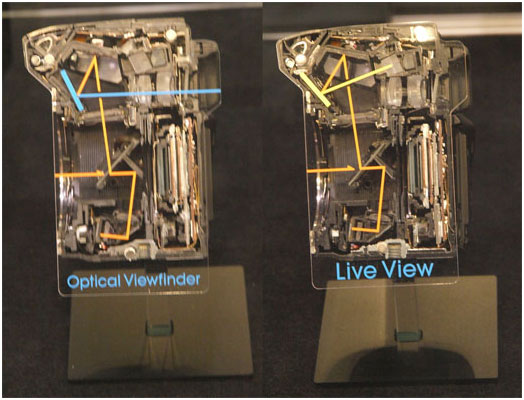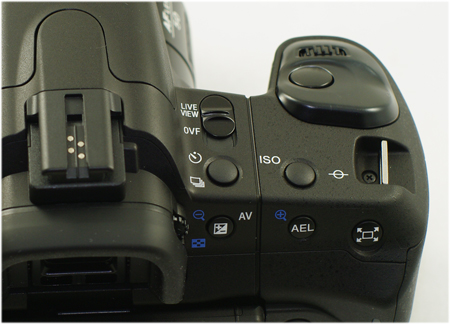Sony A350: Full-Time Live View at 14.2MP
by Wesley Fink on April 3, 2008 3:00 AM EST- Posted in
- Digital Camera
Live View and the Optical Viewfinder
Sony Live View impressed us at PMA, and now that we've spent more time with a production A350 we are even more impressed with the Sony version. Sony Live View is definitely unique compared to others, and their description as Quick AF Live View is justified.
Everyone else now uses the imaging sensor to provide Live View, and while that method works and is fairly cheap to implement, it does have serious limitations. First, it eats precious power, as the mirror has to be flipped up and held out of the image path during Live View. Second, the camera must flip down the mirror for focus and metering, which slows down shooting and momentarily turns off Live View. This makes Live View more a check-box feature on today's digital SLRs than something truly like the Live View seen on Point-and-Shoot cameras. Some variations of this exist, such as the Canon Live View system with contrast-detection focusing that has been announced for the Canon XSi, but all the Live View systems have been slower and less capable than optical AF.

In the A300 and A350, Sony introduces a totally different Live View System, based on an additional live view sensor and a tilting pentamirror. In the Sony Quick AF Live View, the pentamirror tilts and the optical viewfinder closes during live view. It can also run continuously without overheating the sensor, which is an early reported problem with the Canon system.

One huge improvement from the prototypes we saw at PMA is the top mounted switch for Live View or the Optical Viewfinder. It is a mechanical switch that works with or without camera power, and it is exceptionally easy to slide without the excessive resistance we saw on the PMA cameras. When the switch is in Live View, the viewfinder blind closes so there is no mistaking the camera mode.
In our shooting with a production A350, the Quick AF Live View seemed just as fast as the optical viewfinder. Sony specifies a slight speed penalty with Live View, however, with continuous shooting of 2FPS in Live View and 2.5FPS with the Optical Viewfinder. If you look closely at the specs on page two you will see this is slower than the 10.2MP models (A200 and A300) which manage 3FPS with less info to write with the lower-resolution sensor.
Those who are used to the Live View capabilities of their point-and-shoot digitals will love the new Sony A350 and A300. They will seem very familiar and Live View is exceptionally easy to select and use. The bad news is that the 2.7" Live View LCD only shows 90% of the image you will capture. That won't matter for the snapshots LV will mainly be used for, but it is an obvious problem if you are using Live View for high or low-angle Macro shots with the tilting Live View Screen. When you process or review the captured images, there is a lot more around the image than you framed on the Live View screen. Keep that in mind during critical shooting and it will be less of a problem.
Optical Viewfinder
It's a good thing the Live view is useful and fast because the optical viewfinder is absolutely horrible - both dim and tiny with a pronounced "looking down a tunnel" effect. You can see why this is the case with a close look at the viewfinder specs on page two. The top A700 has a good viewfinder with a .90x magnification, and it uses a true pentaprism for a bright clear image.
The 2006 A100 had a decent .83X pentamirror viewfinder that was both larger and brighter than normally seen on cropped sensor DSLR cameras. That viewfinder appears to be carried over intact to the new A200. Then there is the new A350/A300 with a .74X optical viewfinder. The view is reasonably bright - for a light at the end of a tunnel - but the tunnel is so long you are left with the impression that the viewfinder is dim. The screen itself appears tiny and the usefulness of the optical viewfinder is seriously reduced in the A350 and its sister A300.
If you will mainly shoot with the optical viewfinder and don't really care about the tiltable LCD and Live View, then go with the A200 as the viewfinder is much better. The fly in the ointment comes if you want the 14.2MP sensor because the other options are 10MP - and that gives the A350 about 40% higher resolution than the other entry-level Sony cameras.
It's a good thing the A350 has good full-time Live View because we would flunk the camera if we had just the optical viewfinder to depend on. Even the tunnel-like Olympus E-510/410 viewfinders are better than the new A350 - and they are hampered by the smaller sensor with the 2X multiplier. There are ways to get around most viewfinder issues as Olympus showed us with the superb viewfinder in the new E-3, where the small sensor is assisted with a high pentaprism with a 1.15X magnification. The A350 optical viewfinder is usable, but in general it is pretty awful. Sony really needs to improve this viewfinder because it will matter to most users who don't mainly use Live View, and many will be buying this camera for the 14.2MP sensor and not just the Live View.










113 Comments
View All Comments
steveChance - Tuesday, April 29, 2008 - link
[please disregard this post if this topic has been covered already in the readers' comments as I have not read all twelve pages of them]I find it odd that you would test cameras using printed matter as sample subject. Like digital images printed matter (esp. 4-color process) has its own errors that will (IMHO) negatively effect the photographic results.
Use a loupe to view at the actual item shown in the crops...
jcbenten - Friday, April 25, 2008 - link
Nice article. I presume I have come across this with all the corrections. I look forward to comparisons to the XSi, K200, and A300. I am "attempting" to purchase my first (D)SLR and I continue to out think myself. Your A350 crops came out much better than I anticipated. Maybe there is still life in the CCD.punchkin - Tuesday, April 8, 2008 - link
... before performing another "comparison".cputeq - Wednesday, April 9, 2008 - link
You should also consider the text of the review before making snide comments.The review indicated all camera white balance settings were set to Tungsten. If one camera or another has a warmer look than another, that's the "fault" of the camera.
The issue of the image comparisons was noise, not color accuracy.
Zak - Wednesday, April 9, 2008 - link
I'm not saying the review was bad or good, I can't care less for SONY's cameras, and I don't want to put down your efforts, but I think AnandTech is losing focus. Please return to your roots: computer stuff and leave the camera reviews to other established camera review sites that don't do computer stuff review;) When I come here I want to read about about computer stuff. If I want to read about cameras I go to DP Review, Steve's Cams, Digital Camera Resource, Fred Miranda, The Imaging Reource just to name a few. Honestly, I see at least 50% drop in number of interesting articles on AT. Oh, and the same goes for game reviews. XBox game reviews on AT? Please…Zak
MKFAGAN - Monday, April 7, 2008 - link
I was wondering why everyone is down playing the in camera zoom feature this is huge..The way I see it I have a 50mm 1.4 which is actually a 70mm with the 1.6 crop I press the button to get 1.4x zoom this gives me a 98 1.4 lens I press it again I get 2x zoom so I get a 140mm 1.4 thats huge It is like having 3 prime lenses in 1 so what if I lose a few MP This is big could you imagine a 135mm 2.8 with crop factor 216mm 2.8 press the button to 2x zoom I have a 432mm 2.8 this is a huge featureWesley Fink - Tuesday, April 8, 2008 - link
The auto-teleconverter is convenient, but it is really just a crop of the 14.2 megapixel image. You can do that by croppping images from any digital camera. I was also disappointed that the auto teleconverter does not work in Live View mode.In fact, there is no real zoom mode in Live View to assist in focusing, as I learned the hard way in trying to set critical focus for the resolution/noise crops. The tiny viewfinder and no zoom in LV made accurate manual focusing a real chore. While Sony's Live View is the fastest and most convenient LV we have tested, both the Pentax K20D and Olympus E-3 allow you to select an area to enlarge in LV and then magnify it (7X, 10X) for manual focusing - which does work real-time on both cameras. That made manual focusing MUCH easier for the test series on those two cameras.
haplo602 - Thursday, April 10, 2008 - link
Briliant Wesley ... THIS is that kind of information that should have been in the review !!!That's also what I meant in my earlier post. Camera handling and the little quirks that either get in the way or aid in actual shooting.
Maybe I missed the part in the review, but I do not recall you mentioning the auto-teleconverter. Also the LV limitation on focusing (coupled with the horrible viewfinder) are a critical point that should have been in the review.
retired hiker - Monday, April 7, 2008 - link
I have a problem with the title of your review. Tell me how I can Live View at 14.2MP. Certainly the tiny display on the camera can't give me that resolution.krakman - Saturday, April 5, 2008 - link
also they sell fer around 30$ on amazon.